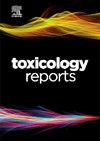真菌β -葡聚糖酶的安全性评价
Q1 Environmental Science
引用次数: 0
摘要
猪和家禽饲料中通常含有-葡聚糖酶,以减轻许多谷物中发现的-葡聚糖的抗营养影响。对β -葡聚糖酶进行了安全性研究,包括皮肤和眼睛刺激、皮肤致敏、90天大鼠口服亚慢性研究和遗传毒性,以评估β -葡聚糖酶作为动物饲料添加剂的安全性。β -葡聚糖酶是通过真菌(里氏木霉)生产菌株发酵产生的,该菌株表达野生型真菌内切葡聚糖酶(egl2)基因,以过表达内切葡聚糖酶(在本文中称为β -葡聚糖酶)酶。预测β -葡聚糖酶在重建的人表皮组织(RhE)和重建的人角膜样上皮(RhCE)中分别对皮肤或眼睛无刺激性(No Category)。β -葡聚糖酶在体外通过直接肽反应性试验(DPRA)、KeratinoSens™试验和人细胞系激活试验(h-CLAT)进行检测。使用2 / 3的方法,基于阴性KeratinoSens™和h-CLAT检测,β -葡聚糖酶不是皮肤增敏剂。体外遗传毒性试验证实-葡聚糖酶无遗传毒性。在为期90天的亚慢性研究中,大鼠每天以0 (milliq®水)、250、500或1000 mg总有机固体(TOS)/kg体重(bw)/天的剂量水平(分别相当于0,42,102、84,205和168,410单位(U)/kg体重/天)灌胃给予β -葡聚糖酶。没有观察到与测试项目相关的不良反应。β -葡聚糖酶的无观察到不良反应水平(NOAEL)为最高试验浓度1000 mg TOS/kg体重/天。根据该NOAEL和根据建议在饲料中添加最大推荐水平(426 U/kg)确定的消耗量估计,根据肉仔鸡(相对体重而言采食量最高的目标品种)的最高预期日采食量计算出5681的安全边际值。该研究结果支持β -葡聚糖酶作为动物饲料添加剂的安全使用。本文章由计算机程序翻译,如有差异,请以英文原文为准。
Safety evaluation of a fungal beta-glucanase
Pig and poultry feed are often included with beta-glucanase to alleviate the anti-nutritional impacts of beta-glucans found in many cereal grains. Safety studies were conducted on beta-glucanase, including skin and eye irritation, dermal sensitization, a 90-day rat oral subchronic study, and genotoxicity, to evaluate the safety of a beta-glucanase for use as an animal feed additive. Beta-glucanase is produced by fermentation with a fungal (Trichoderma reesei) production strain expressing a wild-type fungal endoglucanase (egl2) gene to overexpress the endoglucanase (referred to as beta-glucanase throughout the paper) enzyme. Beta-glucanase was predicted to be non-irritant (No Category) to the skin or eyes in reconstructed human epidermis tissues (RhE) and reconstructed human cornea-like epithelium (RhCE), respectively. Beta-glucanase was tested in vitro in the direct peptide reactivity assay (DPRA), the KeratinoSens™ assay and the human cell line activation test (h-CLAT). Using the 2 out of 3 approach, beta-glucanase was not a dermal sensitizer based on the negative KeratinoSens™ and h-CLAT assays. In vitro genotoxicity testing confirmed beta-glucanase to be non-genotoxic. In the 90-day subchronic study, rats were administered beta-glucanase daily via oral gavage at dose-levels of 0 (Milli-Q® water), 250, 500 or 1000 mg total organic solids (TOS)/kg bodyweight (bw)/day (equivalent to 0; 42,102; 84,205 and 168,410 units (U)/kg bw/day, respectively). No test item-related adverse effects were observed. A no-observed-adverse-effect level (NOAEL) for beta-glucanase was established at 1000 mg TOS/kg body weight/day, the highest test concentration. Based on this NOAEL and an estimate of consumption determined from the proposed inclusion of the beta-glucanase in feed at the maximum recommended level (426 U/kg), a margin of safety value of 5681 was calculated based on highest expected daily feed intake in broilers, the target species with highest feed intake relative to body weight. The findings support the safe use of beta-glucanase as an animal feed additive.
求助全文
通过发布文献求助,成功后即可免费获取论文全文。
去求助
来源期刊

Toxicology Reports
Environmental Science-Health, Toxicology and Mutagenesis
CiteScore
7.60
自引率
0.00%
发文量
228
审稿时长
11 weeks
 求助内容:
求助内容: 应助结果提醒方式:
应助结果提醒方式:


